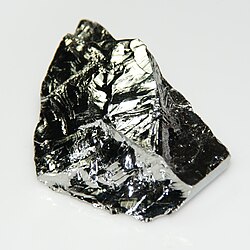Germanium
Because very few minerals contain it in high concentration, germanium was discovered comparatively late in the history of chemistry. Germanium ranks near fiftieth in relative abundance of the elements in the Earth's crust. In 1869, Dmitri Mendeleev predicted its existence and some of its properties based on its position on his periodic table and called the element ekasilicon. Nearly two decades later, in 1886, Clemens Winkler found the new element along with silver and sulfur, in a rare mineral called argyrodite. Although the new element somewhat resembled arsenic and antimony in appearance, its combining ratios in the new element's compounds agreed with Mendeleev's predictions for a predicted relative of silicon. Winkler named the element after his country, Germany. Today, germanium is mined primarily from sphalerite (the primary ore of zinc), though germanium is also recovered commercially from silver, lead, and copper ores.
Germanium "metal" (isolated germanium) is used as semiconductor in transistors and various other electronic devices. Historically the first decade of semiconductor electronics were entirely based on germanium, although its production for such use today is a small fraction (2%) of that of ultra-high purity silicon, which has largely replaced it. Germanium's major end uses in the present are fiber-optic systems and infrared optics. It is used in solar cell applications. Germanium compounds are used for polymerization catalysts. Germanium is finding a new use in nanowires. Germanium forms a large number of organometallic compounds, such as tetraethylgermane, which are useful in chemistry.
Germanium is not thought to be an essential element for any living organism. Some complexed organic germanium compounds are being investigated as possible pharmaceuticals but none has had success. Similar to silicon and aluminum, natural germanium compounds, which tend to be insoluble in water, have little oral toxicity. However, synthetic soluble germanium salts are nephrotoxic, and synthetic chemically reactive germanium compounds with halogens and hydrogen are irritants and toxins.
Occurrence
Germanium is created through stellar nucleosynthesis, mostly by the s-process in asymptotic giant branch stars. The s-process is a slow neutron capture of lighter elements inside pulsating red giant stars.Germanium has been detected in the atmosphere of Jupiter and in some of the most distant stars. Its abundance in the Earth's crust is approximately 1.6 ppm. There are only a few minerals like argyrodite, briartite, germanite, and renierite that contain appreciable amounts of germanium, but no mineable deposits exist for any of them. Some zinc-copper-lead ore bodies contain enough germanium that it can be extracted from the final ore concentrate. An unusual enrichment process causes a high content of germanium in some coal seams, which was discovered by Victor Moritz Goldschmidt during a broad survey for germanium deposits. The highest concentration ever found was in the Hartley coal ash with up to 1.6% of germanium. The coal deposits near Xilinhaote, Inner Mongolia, contain an estimated 1600 tonnes of germanium.
| Symbol | Ge | |
| Atomic Number | 32 | |
| Atomic Weight | 72.61 | |
| Oxidation States | +2,+4 | |
| Electronegativity, Pauling | 2.01 | |
| State at RT | Solid, Metalloid | |
| Melting Point, K | 1210.6 | |
| Boiling Point, K | 3103 |
Appearance and Characteristics
Harmful effects:
Germanium is not known to be toxic.
Characteristics:
- Germanium is a lustrous, hard, gray-white semi-metallic element with a crystalline and brittle structure.
- It is a semiconductor.
- Germanium and the oxide are transparent to infrared radiation.
- Germanium also has the unusual property that (like water) it expands as it freezes.
- Four other elements expand when they freeze; silicon, bismuth, antimony and gallium.
Uses of Germanium
- The most common use of germanium is as a semiconductor.
- Germanium is used in transistors and in integrated circuits.
- It is used as an alloying agent and as a catalyst.
- It is also used in infrared spectroscopes and infrared detectors.
- Some germanium compounds are useful because they are toxic to bacteria but are harmless for mammals.
